Text
Bibliography
Philip Jones Griffiths. Northern Ireland Magnum photos: https://pro.magnumphotos.com/C.aspx?VP3=SearchResult_VPage&STID=2S5RYDYEL540
Edward Burke, 2018, An Army of Tribes, Liverpool University Press.
Brian Hamill Gallery talk: https://www.youtube.com/watch?v=ndxrI4oS3A0
The Troubles, Brian Hamill website: https://www.brianhamill.com/the-troubles
Dr Eamon Phoenix, 2018, 1993: What was happening in the year of the latest state papers, Irish News: http://www.irishnews.com/news/statepapers/2018/08/24/news/state-papers-the-year-1993-in-northern-ireland-1414607/
PR Intern, 2017, Underground – Para turned photographer: http://www.underground-england.co.uk/news/stuart-griffiths-para-turned-photographer/
Bruno Bayley, 2011 , Stuart Griffiths Interview, VICE: https://www.vice.com/en_uk/article/xd4zew/stuart-griffiths-interview-myth-of-the-airborne-warrior-pigs-disco-army-book
Stuart Griffiths, 2013, Pigs’ Disco Book
Daylight Magazine, 2012, The Myth of the Airborne Warrior, The Telegraph: https://www.telegraph.co.uk/culture/photography/9734685/The-Myth-of-The-Airborne-Warrior.html
Tom Burke, 2019, Shooting the Darkness Book, Blackstaff Press, Newtwonards.
June 2010, Report of Bloody Sunday Inquiry, GOV.UK: https://www.gov.uk/government/publications/report-of-the-bloody-sunday-inquiry
June 2010, David Cameron’s full statement - Bloody Sunday, BBC News: https://www.bbc.co.uk/news/10322295
Mark Bain, 2019, Lensman Stanley Matchett on the Troubles he’s seen - Belfast Telegraph: https://www.belfasttelegraph.co.uk/news/northern-ireland/lensman-stanley-on-the-troubles-hes-seen-37762746.html
Freya McClements, 2019, ‘ I was hoping they wouldn’t shoot us when they saw the cameraman’, Irish Times: https://www.irishtimes.com/news/ireland/irish-news/i-was-hoping-they-wouldn-t-shoot-us-when-they-saw-the-cameraman-1.3824551
Ardoyne Book, 2019 , Belfast Archive Project , Belfast
Bobbie Hanvey photographic archives – 2009, Boston College Libraries: https://www.bc.edu/sites/libraries/hanvey/index.html
Victor Sloan website, Visual Artist: http://www.victorsloan.com
Belfast Archive Project, Frankie Quinn, 2019: http://www.belfastarchiveproject.com/frankie-quinn-peacelinesi
Cordon Sanitaire Book, Frankie Quinn, 2019
Irish News, Frankie Quinn, 2019: https://www.irishnews.com/arts/2019/09/04/news/belfast-peace-walls-the-focus-of-photographer-frankie-quinn-s-cordon-sanitaire-1702353/
Wee Muckers Book, Toby Binder, 2019, Kehrer Verlag Heidelberg Berlin:
Huck – by Cian Traynor - Wee Muckers 2019: https://www.huckmag.com/art-and-culture/photography-2/toby-binder-wee-muckers-belfast-youth-brexit/
BBC Worldwide/Wall to wall – South Armagh Northern Ireland 2006: https://veetoo.com/project/video-production-belfast-2/
Steidl Books, British Watchtowers, Donovan Wylie: https://steidl.de/Books/British-Watchtowers-0329323456.html
The Genius of Photography
The Guardian,2013, Spies like Us: Donavon Wylie, Sean O’Hagan: https://www.theguardian.com/artanddesign/2013/oct/24/donovan-wylie-vision-as-power-exhibition
SAATCHI Gallery: https://www.saatchigallery.com/artists/artpages/richard_billingham_untitled1.htm
The Gaurdian 2012- Richard Billingham: ‘I just hated growing up in that tower block’: https://www.theguardian.com/artanddesign/2016/mar/13/richard-billingham-tower-block-white-dee-rays-a-laugh-liz
Ray and Liz official trailer: https://www.youtube.com/watch?v=TLaMmSzOxVI
0 notes
Text
21. Antoine d’Agata Exhibition review
On the 7th of November, I visited Belfast Exposed for the artist talk relating to Antoine d’Agata’s Belfast work. Antoine is a renowned Magnum artist that deals with aspects of life that people don’t like to talk about, such as sex, prostitution and drugs. Belfast Exposed commissioned him to create an exhibition that reflected his response to contemporary Belfast. We’re now twenty one years into relative peace; A lot has changed but many of the problems that were the root causes of conflict still exist today such as segregated housing, segregated schools and a lack of shared identity.
Antoine was only in Belfast for two weeks so he felt it was quite difficult to access contacts, take the photos, record the stories and then complete the final edits. He took up residency in Belfast Exposed and described it as a ‘live lab’, where he carried out most of his research, stuck contact sheets up on the wall, editied and printed all of his work. During this time, he explored the city, from the busy city centre to the tranquillity of the suburbs and documented his own experience and perspective of this changing city. Throughout his stay, he met with eleven individuals from different parts of Belfast who then shared stories and experiences of living in city.
Contemporary Belfast
Antoine ventured to Belfast at an interesting time. With the uncertainty of Brexit, the lack of a Stormont government and changing laws regarding major social issues such as same sex marriage and abortion, it provided him with the perfect opportunity to explore the current vibe of the city. The people he interviewed came from a range of ages, races, religions backgrounds and demographics. This meant his exhibition really did reflect contemporary Belfast, as we’re much more of a diverse city than we were twenty years ago.
The Exhibition
The exhibition was presented in a way that incorporated his own daily notes, photographs that related to the structure of contemporary Belfast architecture, a contact page, an image of someone within the area he photographed and then a long role of paper that included the word for word interview with one of eleven people. This theme was repeated eleven times within the confines of the exhibition studio.
Before I went to the exhibition, I had been researching some of his past work. I’d made up in my mind a certain idea of what it was going to be like, but when I got there it was very different. Instead of being really provocative, there was a certain silence to it. This contradicts the name of the exhibition; Eleven Voices. Most of the larger photographs of Belfast had no life in them. They were images that showcased a walled or fenced in city.
Many photographers have come to Northern Ireland and photographed the peace walls, however Antoine wasn’t focussing on those structures. Instead he was reflecting on his own perspective. He said at the talk, “Belfast is not a fluid city. It’s like blocks”. What I think he was referring to was the nature of the physical architecture throughout many segregated areas of the city. It’s like partition doesn’t just exist on the island of Ireland; it also exists within Belfast neighbourhoods. After the sectarian trouble that spread throughout many parts of the city and destroyed much of it’s old terrace housing, a new way of living had to be created. I remember Frankie Quinn talking about this at his latest Cordon Sanitaire exhibition which was a reflection of fifty years of the peace walls.
The definition of Cordon Sanitaire is:
“ A measure designed to prevent communication or the spread of undesirable influences.”
This is what Antoine was experiencing. These cul-de-sacs, small brick walls and large fences around people’s homes were all designed years ago by the Department of Communities to reduce confrontation between the two main communities. In regards to these photographs, I think Antoine showed this well through the use of imagery that was all edited to look slightly underexposed. This gave the sense that there is a hidden agenda that no one knows about, which is probably true in regards to the segregated structure of contemporary architecture in Belfast.
I didn’t really understand the photographs of people. They were people within the area he photographed however I thought it would have been better to photograph the people he had interviewed. It meant the people who were interviewed were pushed aside, but I suppose he was playing on the word ‘voices’. Maybe he wanted to make sure it was only their voices being heard, whereas a photograph may contradict that slightly.
Antoine included his own personal notes within the exhibition. These were short notes he made on a daily basis to help him form his own idea of contemporary Belfast. Sometimes he wrote news headlines down, his own thoughts or quotes from a book. This was helpful for me as the viewer as it allowed me to realise his own thought process throughout his time spent in Belfast.
Overall, I thought the exhibition was an interesting one that did reflect the grotty nature of secret agendas that exist within post conflict societies. I enjoyed reading the personal stories of the local people. Many of them talked about what it was like growing up in Belfast rather than the Belfast of today, but I suppose that reflects where we’re at as a society. We haven’t dealt with the past so it keeps coming back to bite us.
A famous quote by the late David Ervine:
“Those who forget the past are condemned to repeat it”
0 notes
Text
20. Murder in the family

The above photograph was taken by my Granda during a family holiday in Coleraine in 1973. My family have always been a very close family. We stay in touch, visit each other often and we also used to holiday together. In the picture above, it shows my Dad, Uncle, Granny, Great- Aunties and Great -Granma. It was taken the day before three of them were killed and one was seriously injured. As they walked along the high street in Coleraine, a car bomb exploded and killed six people in total, three of whom were from my family. The blast also injured many people as well including a six year-old girl. The IRA planted two bombs in Coleraine that day. They later issued a statement saying they had mistakenly given the wrong location for the first bomb….Unfortunately their ‘mistake’ had cut short the lives of six innocent people.
This particular photograph is very important to my family members. I often hear my Granny and her sisters talk about this day, what they got up to and then how it suddenly ended in darkness. I find the picture rather haunting. Here they were, on holiday enjoying themselves, but none of them new what was coming.
The next day their lives would change forever. It’s a poignant and evocative image because every time I hear my Granny talk about the death of her family members it fills her with sadness. This makes me feel slightly sad as well. Even though I’m too young to have known them, I’ve grown up hearing lots about them. I feel like I’ve known them and I also feel like I was robbed of the chance of getting to know them.
The ladies in the blue and red coats, as well as the man in the brown suit were killed.
I wasn’t sure if I wanted to include this bit in my blog however I thought it was relevant due to the fact my starting image was about the Troubles. The Troubles left a lasting scar on my own family, just as it did for many other families throughout this Province.
0 notes
Text
19. Richard Billingham - Family Life research.
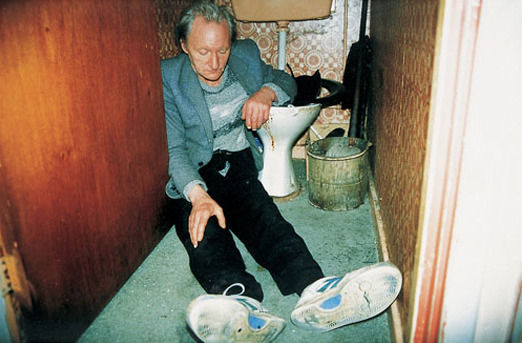
I’ve known about Richard’s work regarding his family life for quite sometime, however I’ve never really looked into it with great depth. If we’re talking about photographing our family life as a document of truth then I think Billingham’s photographs are a great example. His work changed perceptions of how we could photograph our family. Instead of showing the ideal staged picture of smiling families, Richard decided to capture real life moments within the household. None of his photos were staged or constructed. They focussed in on the difficulties that many families face on a daily basis such as alcoholism and how it affects others within the family.
Richard comes from working-class housing estate in Birmingham. His family project focuses on his father Raymond: his mother Elisabeth and his brother Jason.
“Ray is a chronic alcoholic and has drunk for as long as I can remember. He has not worked since he was made redundant from his job as a machinist around 1980. Liz very rarely drinks but she does smoke a lot of cigarettes.” – Richard Billingham
The above quote by Richard tells me a lot about the reasons behind why his family life was the way it was. Ray being a working-class man most likely left school and got a job straight away without the need of further education. This job probably provided him with a sense of security throughout his life. In those days, he would have been perceived as the ‘man of the house’; the person that put the bread on the table. However, when Ray lost his job he maybe lost his sense of belonging. This can have major effect on a person. They can instantly feel insecure and then turn to the likes of alcohol as a coping mechanism. Throughout Richards photographs we see Ray in a vulnerable position (just like the photograph above). No longer is he the so called ‘man of the house’; now his own wife has to look after him.
I noticed in the quote above, Richard said Liz rarely drinks but does smoke a lot of cigarettes. Maybe Liz see’s what drink has done to her husband. She doesn’t want to end up that way, however she still needs some sort of stress relief. This relief may be found whenever she chain-smokes.
The story of his parents is now being shown as a film called ‘Ray & Liz’. It brings the narrative in the photographs to life and helps me as the viewer to visually understand the two characters, their mannerisms and what life was like for Richard growing up in a post- Thatcher British working-class community.
0 notes
Text
18. Additional Research
Photography and family
The Genius of photography – We are family (watched in class)
“The only thing you can really photograph is your own tribe. “ – Nan Golden
Some of the most intriguing photographs are taken at home amongst our family. The quote above by Nan Golden is interesting. Our ‘tribe’ refers to who we belong to. What I think she’s trying to say is that we know our families better than anyone else. We know what makes them tick, we know what makes them happy and for most of us we’ve seen them at their worst. No family is perfect. We rub alongside these people every day so there’s bound to be friction, however the bond within a family unit is such a special thing because it allows us to witness the highs and lows of family life, such as the anxieties, the fears, the disagreements and also the love and affection we experience as well.
I personally think Golden is trying to compare our families to a strange subject we may come across on the street. If I picked up a camera and went out onto the streets to photograph daily life in Belfast, I may come across characters that I may stop and chat with for a bit before taking their picture. This is completely different to the relationship we have with our family members. In the home, there are generally roles and responsibilities; for example the role of a Father, a Mother and a child. From my own experience, whenever I lift the camera up to photograph someone in the house, my relationship with my family member changes. It becomes awkward and slightly strained. Is this because the camera conflicts with the family roles? When I reflect on it, the act of lifting the camera up to your face and photographing someone within a personal environment such as the home is an unusual experience. I can’t expect them to instantly act normal whenever they know they’re under some sort of spotlight.
0 notes
Text
17. Donovan Wylie – Watchtowers
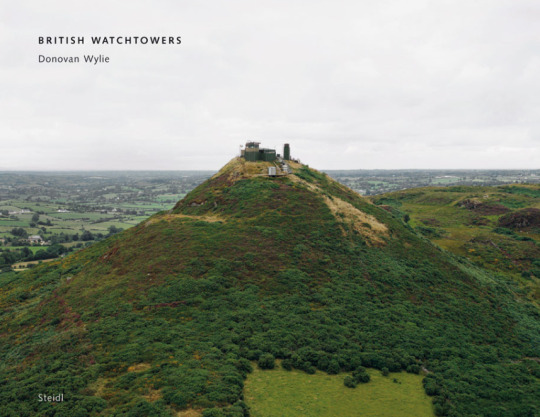
As my blog is soon coming to a conclusion, I thought I would concentrate on work that is relatively new. I started the blog with a photograph of a young Scottish soldier serving in Belfast in the early 70s, so I think it’s fitting to finish with a photograph that was taken during the final days of the British Army operation in Northern Ireland.
When troops were initially deployed onto the streets, no one could have imagined they would have stayed for thirty-eight years, however as the violence escalated the British Army’s response was one of heavy militarization throughout Northern Ireland. In the mid 1980s, the army constructed watchtowers along the border regions with the aim of surveying any terrorist related activity, particularly in places like South Armagh.
In the early 2000s, as the peace process was gaining momentum, the British government announced a ‘Demilitarization’ process that would see a dramatic reduction in military activity on the streets and borderlands of Northern Ireland; this took place between 2000 and 2007.
Throughout this period Donovan Wylie photographed these watchtowers from an army helicopter, with the aim of surveying the towers, their positions and their perspectives within the landscape.
I was drawn to this series of photographs for a number of reasons. First of all, to be able to take photographs from this position requires a great deal of effort. Donavon wanted to make sure his photos were taken from the same height and perspective as these watchtowers. In doing this, he has created a new way of looking at these fortifications. Instead of being down on the ground and looking up at these weird structures, the viewer can nearly have ‘eye-to-eye’ contact with them. I noticed all of the images have been composed in a way that makes sure the watchtowers are in the center of the frame. In doing this, it immediately draws my attention to what Donovan is trying to highlight. The fact we can see the mountains, surrounded by a rural landscape and then amid all of this we see a strange skeletal structure that doesn’t seem to fit in with the natural landscape of the area.
Another factor that caught my attention was the medieval look of these military observation posts. They remind me of the Motte and Bailey castles that were built on hilltops to prevent attack from those below. The fact that this was the early 2000s makes it rather confusing; it doesn’t fit in with the area and the time. In a way they ‘stick out like a sore thumb’.
“The system of Iron Age forts, survey the surrounding landscape. Two thousand years later, the British army used a similar system of watchtowers to survey the territories of Northern Ireland, and to observe the actions of the local people under their occupation” – Steidl Books review
The use of space within the frame adds a new dimension to the overall image. It creates a new way of looking at these tall and heavily armoured structures. Instead of looking big and scary, it makes them look small and insignificant. He took these photographs at a time when there was barely a trace of the British Army’s physical presence in places like South Armagh. The fact these structures weren’t occupied at the time creates a haunting atmosphere.
0 notes
Text
16.
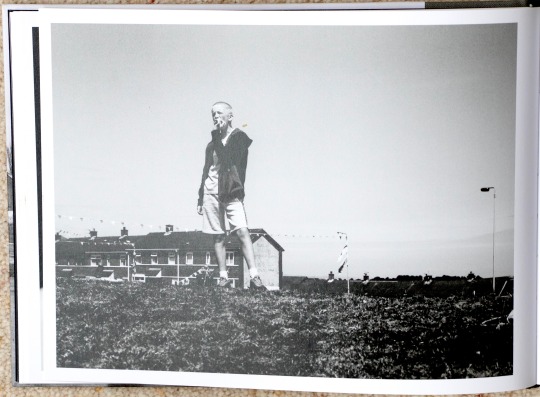
There are many fantastic photographs throughout this photobook, however the image above is one of my personal favourites. It was taken in Highfield Estate during the summer of 2018. The young lad looks to be about fourteen or fifteen. He’s standing on a hilltop that’s slightly raised up from the homes that can be seen behind him; I suppose this goes well with the term ‘Highfield’. The way in which he is standing is one of the factors that draws me to the image. His confident pose, with one hand up to his mouth smoking a cigarette suggests to me that he’s streetwise. He looks as if he knows his environment, he’s not afraid of anything and he’s proud to come from this estate.
The fact the photograph is in black and white adds to the different contrasts, tones and textures within the frame. The young lad is a ‘skinhead’. This and the fact there’s flags in the background reminds me of a still from the TV series ‘This is England’. The photograph has a roughness about it. It’s raw, it’s real and it showcases the rebellious aspect of teenage life.
1 note
·
View note
Text
15. Toby Binder - Contemporary Northern Ireland

Wee Muckers Book
During the summer I attended the signing of Toby Binder’s new book; ‘Wee Muckers’. The work focuses on the youth in contemporary Belfast, twenty-one years after the signing of the Good Friday Agreement. The term, ‘Wee Muckers’ refers to the local phrase used by young people to describe their mate. At first, I fell in love with the book due to the wide variety of photographs, the feel of the paper in which photos were printed on and its general layout. It’s comprised with wonderful documentary shots and intimate staged portraits.
Toby concentrated on six different working-class areas throughout Belfast. These were the Shankill, Highfield Estate, Clonard, Carrick Hill, the Village and Sandy Row. He made sure he included both Catholic and Protestant districts and then began photographing local teenagers throughout the events during summer. The photography work explores the life of young people in this divided city at a difficult time, between the lack of local government and the uncertainty surrounding Brexit.
Although Toby had previously visited Northern Ireland, he returned straight after the Brexit referendum to concentrate on this photo essay. In doing this, he has managed to capture the here and now. As it stands, Northern Ireland is at the crossroads; no one really knows what the ramifications of Brexit will be. Issues such as unemployment, drug crime and violence are explored within the book. Whilst some people would like to make out that people on both sides of the divide are very different, it’s obvious from Toby’s work that there’s more that unites them compared to that in which divides them. The difficulties that working-class communities face doesn’t just affect one side of the peace wall, it affects both sides.
0 notes
Text
14. Frankie Quinn - Effect of Conflict
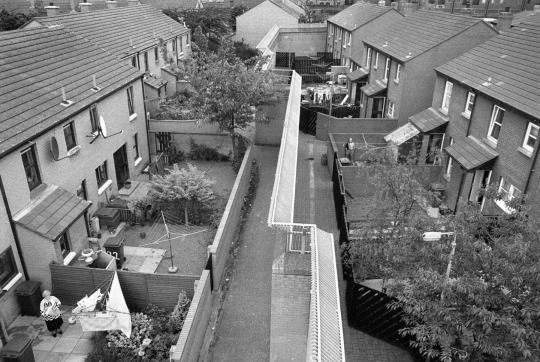
Whilst many photographers have photographed the tragic events of the Troubles, Frankie Quinn has documented the effect conflict has had on Northern Irish society. In September, I attended the launch of Frankie’s latest exhibition; ‘Cordon Sanitaire’. Fifty years after the first peace wall was built, this exhibition focused on what these structures are made of and how they’ve shaped the communities that live alongside them. The exhibition concentrated on Frankie’s contemporary photography, however there was a small showing of his first peace wall series taken shortly after the ceasefires in 1994. All of these photos were taken on an old black and white 35mm film camera. Many of them capture the daily life of those living in the shadow of the wall.
When attending the exhibition, one particular photograph caught my attention, so I asked Frankie to tell me a bit about the story behind this image. It was taken in the summer of 1994 during the filming of a BBC documentary that focused on life in divided Belfast. The cameramen were using a cherry picker to enable them to show a different perspective of the wall that divided the Republican Short Strand and the Loyalist Cluan Place areas. Frankie asked if he would be able to take a photograph from the cherry picker; the camera crew agreed.
In a way this photograph was constructed because Frankie arranged for Peggy (bottom left) and David (top right) to stand outside their backyards whilst the photo was being taken. The concept behind the photograph was to physically show the effect segregation has had on local working-class communities. Here we see two neighbours who have lived alongside each other for years, but do not know each other. The wall itself somewhat represents a line in the sand or a barrier to true peace. It nearly divides the photograph itself due to the fact it runs straight through the center of the image. As the viewer, we can see the similarities on both sides; we can see that the houses on the left are the same style of houses on the right, the backyards are similar and the alleyway that runs alongside the wall is the same. We, as the viewer can see this but the people who live in those houses can’t.
Personally, I find the reality of this photo rather stark. It’s a powerful image that illustrates the danger of segregation and division. Whilst the conflict was drawing to a close, communities were still as divided as ever. This was one of the root causes of the Troubles in the first place, therefore as a viewer it’s quite concerning to see that one of the root causes of conflict was still ‘alive and well’ in the 1990s.
0 notes
Text
13. Victor Sloan: Art and Photography
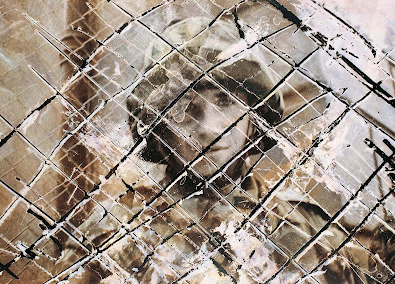
A lot of the images that I’ve chosen so far have been the classic ‘fly on the wall’ documentary style photographs, so I want to do some research into photography as a construct. Victor Sloan is well known throughout Northern Ireland for both his artwork and his photography. Many of the photographs he took were documentary scenes from the Troubles, such as orange marches, protests and the security forces. What gave his work character and made it different to others was the fact that he edited his photographs using physical methods.
Sloan bleached, dyed, scratched, scraped and scored his negatives, which in my view created a whirlwind of emotions. He didn’t do this simply because he was visually attracted to the outcome; he done it because he wanted to reflect the frustration that ordinary people felt during the Troubles. People were fed up turning on their TVs and listening to a relentless cycle of depressing news. In a way Victor’s artwork was the voice of the many, not the few.
Just like the original image I chose of the Scottish soldier on the streets of Belfast, Victor Sloan always captured the security forces as they patrolled our neighborhoods. The photograph above shows a close up shot of a young soldier. It was taken in Lurgan after a bomb attack. I was initially drawn to the image because of how ‘soft’ the soldier looks. Usually when we think of the army, we think of tough men who aren’t afraid of anything, yet this image showcases the opposite. I’m drawn to the soldier’s eyes. They suck the viewer into the photograph. It’s more like a nice portrait of someone, rather than a candid street photography shot of a soldier attending the scene of a bomb.
Sloan has bleached the image, used dyes and scraped the negative to create a form of abstract art. This has created unique tones and textures that give the image depth. We don’t exactly know what Victor was thinking whenever he was physically manipulating the negative; instead it’s left to us to make up our minds. He’s scraped crisscross lines over the top of the soldier. It reminds me of the large iron gates you see at a medieval fortress or castle. It leaves me with the question; what was Sloan thinking of when he created this piece?
I suppose I’ll never know unless I ask him. There’s no caption or information about this particular image, so it’s left up to the viewer to interpret. Maybe Sloan wants to illustrate the barrier effect in which the Troubles had on so many people. It held the people of Northern Ireland back for so many years. The youthful soldier could be doing something else; instead he’s trapped in a depressing situation that never seems to end. He might be on the side of conflict, but looking through the iron gates to the side of peace.
0 notes
Text
12. Construction of the Paisley photo.
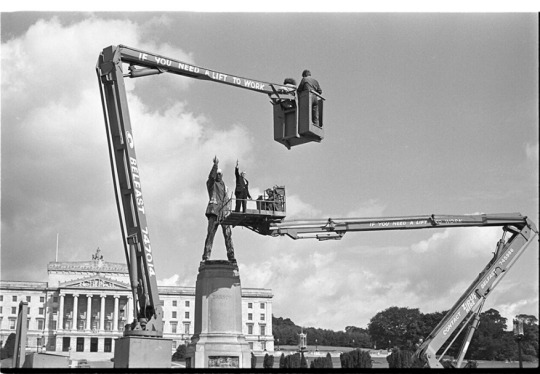
The above image shows what was needed to create this iconic photograph of Ian Paisley and Edward Carson.
0 notes
Text
11. Bobbie Hanvey - Paisley
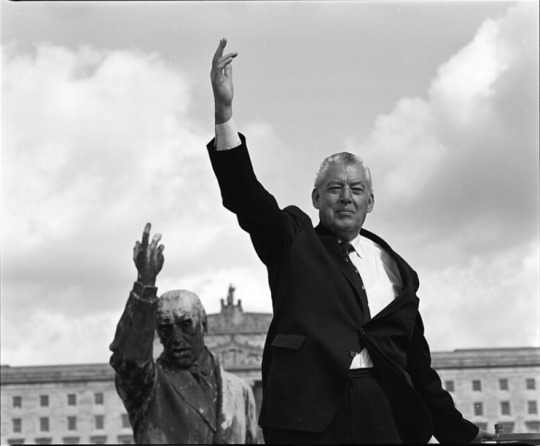
Another image from Bobbie’s collection that I want to analyse is this photograph, which was staged and constructed with Ian Paisley. It’s not the first time I’ve seen this image. It’s sometimes used in contemporary news articles when discussing points relating to this man. The photograph shows Ian Paisley imitating Sir Edward Carson within the grounds of Stormont. Obviously it took some time to time to construct. To be able to get Paisley to be a similar height as the tall statue would be very difficult. Hanvey used two large cherry pickers to enable him to do this. Paisley stood on one of the cherry pickers, whilst Bobbie photographed from the other. This allowed him to create the space that was needed and get the correct perspective.
Concept behind the photograph
This was a journalistic shot taken for a newspaper at the time of the Ulster Says No rallies. Ian Paisley was the figurehead of this movement, therefore I feel like the concept behind the image was to compare him with Lord Carson. It was well known that Paisley idolised Carson and saw him as thee great leader of Unionism. Carson used to be the leader of the largest Unionist party, but at the time of this photograph, it was Ian Paisley who was the leader of the largest Unionist party. This therefore meant there was a similarity.
I think this is a successful photograph for a number of reasons. Ian Paisley and Carson look quite similar. They’ve the same build, same hairstyle and a similar face. The fact that Paisley is striking the same pose tells me that he wanted to be like him. He wanted to have the same power and authority. Whilst the perspective makes it look as if Ian Paisley was bigger than the statue, this creates a foreground and a background. Paisley was in the foreground, which represented modern day Unionism, whilst Carson was in the background. This represented the past.
0 notes
Text
10. Bobbie Hanvey

Politicians and Activists series
Whilst essentially the conflict in Northern Ireland was a sectarian one, it was also morphed around politics and the major constitutional question. The political side of the Troubles is another avenue I want to explore. Many press photographers snapped local politicians speaking at rallies and protests, however not many were able to capture the more intimate portraits the way Bobbie Hanvey did.
I first came across his work whenever I met him down at the gates of Harland and Wolff. I was down there documenting the strike for my first documentary module and he was also there photographing the striking workers. Someone told me to go and have a word with him, so I did and we both started chatting. I then came home and looked at his work. Straight away I was drawn to his photography and the way in which he photographed his subjects.
Bobbie, also known as the ‘Rambling man’ has photographed the people and life in Northern Ireland for over forty years. I suppose you could say the genre in which Hanvey’s work falls under is journalism, however he does it in a way that’s unique to him. His photography is comprised of portraits, candid images and journalistic work such as Paramilitaries, protests and rallies.
I want to focus on some of his political portraits. They fall under the ‘constructed image’ due to the fact they were staged. The above is a portrait of Eamon McCan; a civil rights activist, writer and journalist from Derry. This photograph forms part of Hanvey’s ‘close-up’ series. I’ve tried to do some research regarding where the image was taken, however no information was provided. I presume it was either taken in Bobbie’s studio or a makeshift studio in Derry.
At first I was captured by the detail in this photo. When I was viewing it on the website, you could really see every small feature due to the fact Bobbie took the image on large format. I felt as if I was in the room with Eamon because he is engaging with the camera. As a viewer, this gives me a point of focus, which in return helps me engage with the image. The shallow depth of field is visually aesthetic and helps me focus only on Eamon. I’m not distracted by anything else in the frame.
I suppose you could say it’s a typical portrait photograph. It’s a close-up image which focuses on the head and shoulders of the subject. I feel like this perspective was extremely important at the time. People were seeing these politicians and activists on the television. They saw them shouting at rallies and protests, however this photograph, with this style of composition creates a different atmosphere. It’s somewhat relaxed. There’s a calming feel to it. This may have been Bobbie’s intention at the time.
0 notes
Text
9. Children in Conflict
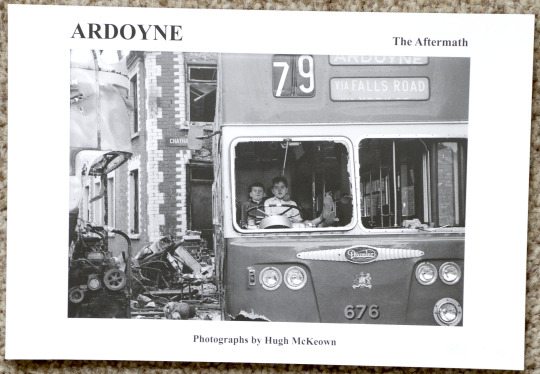
Ardoyne - The Aftermath ( Belfast Archive Project book)
I wanted to try and think about others in our society who can be affected by conflict. I came across this photograph in one of my Granda’s photo books. The book contains Hugh McKeown’s images from the initial aftermath of sectarian rioting in Ardoyne. The day after some of the worst violence in North Belfast, Hugh picked up his camera and walked the rows of war torn streets. What he captured was quite remarkable as it truly reflected the devastation after one night of sustained interface violence.
There were many intriguing photographs in the book, but I was drawn to this one due to its slightly humorous nature. It shows two young boys sitting in the driver’s seat of a burnt out bus. At first, the image makes you look twice. The photograph has a sense of juxtaposition. It’s not a normal thing to see young boys under the age of ten driving a double decker bus, but then I quickly realized the windows had been smashed and the bus was used as a street barricade to divide the two fighting factions.
To the left of the frame we see another burnt out double decker bus, along with what looks like burnt debris on the ground. This may have fallen from the bus or the building behind, as it looks as if the house/shop behind the buses has been set alight as well. The whole image is an iconic photograph that reflects Belfast in the early period of the Troubles. On the bus in which the children are pretending to drive, it clearly says the location of where the bus was going. At the top it says ‘Ardoyne’ followed by, ‘Via Falls Road’. That small bit of detail within the image is quite important as it shows the environment in which the bus was heading to; one of trouble, rioting and hijacking. At the time in which this image was taken, places like Ardoyne and the Falls Road were some of the most notorious areas for violence, therefore I can understand why the author of this book included this image on the front cover. It shows the viewer what the area was like at the time.
The fact the children are playing in this hijacked, burnt out bus shows me that kids will turn something negative into a positive. In most conflicts, children and civilians have to just get on with daily life. War and violence can’t and wont stop them from doing what they usually do. People are quite resilient in that way and I think in this photograph, it shows the resilience of these children. They’ve probably woken up to their area looking like a war zone, with barricades, burn houses, soldiers and barbed wire, however they probably find the whole situation quite exciting. As a child, we don’t fully understand the consequences of conflict. Instead we see it as a new environment that needs to be explored. Notice the child on the right has his feet up on the front of the bus. He looks rather content. He doesn’t seem worried or alarmed. The boy on the left seems to be smiling for the camera. He too looks relaxed. Maybe by this stage they were used to violence in their area. Maybe it was what they’d grown up with. It’s with that conclusion that makes the overall image a fascinating one to read and analyse.
0 notes
Text
8.Contradiction

Stanley Matchett - Another side to the paratrooper?
“On 20th March 1971, less than two months after Bloody Sunday, there was the first retaliation. I was sitting at my desk when I heard an explosion. I said, ‘God that’s a bomb.’ The camera was always sitting on the desk with a fresh roll of film in it so I grabbed it and ran down to be confronted by absolute carnage.” - Stanley Matchett, Shooting the Darkness.
This image was taken in 1972; the same year as the first photograph I chose for this blog. After looking through the photographs in the ‘Shooting the Darkness’ book, I came across this eye-catching photo. At first I was struck by how young the soldier looks. He looks like a boy in a mans uniform. It’s obvious from the badge on his beret that he belongs to the Parachute Regiment.
Immediately I began to think of the soldiers who were involved in Bloody Sunday. It was the same regiment that caused havoc that day which resulted in the deaths of thirteen innocent people. In the days, weeks and months after Bloody Sunday, hostility towards the Parachute Regiment grew throughout Northern Ireland. They were seen as murdering monsters within the Catholic/Nationalist community and were definitely a force to be hated.
However this image above is very contradictory to that narrative. On one hand we see soldiers of the Parachute Regiment as cold blooded murderers and then on the other hand we see a young paratrooper comforting a woman after a bomb blast in the centre of Belfast. The woman looks as if she’s crying and covered in blood. The young soldier hugs onto her as a sign of comfort and reassurance. Due to the way his hands are gripping onto her, it seems as if he’s really trying to ease her pain or shock. The expression on the young soldier’s face is one of worry and panic. He also looks a little confused. He’s probably from England. This could possibly be his first tour as a soldier. He's maybe never experienced violence on this scale before. He’s been thrown into the thick fo things and maybe doesn’t feel properly equipped for the situation.
“In this picture, a paratrooper is comforting a young girl who was seriously injured in the explosion. She was a Czechoslovakian student at the art college; she recovered from her injuries and now lives in Canada.” - Stanley Matchett
0 notes
Photo
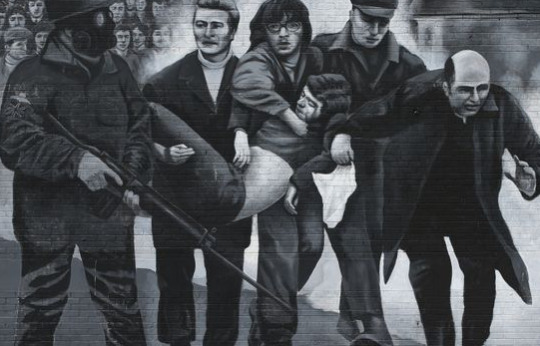
Stanley’s famous photograph is replicated on a wall mural in the Bogside area of Derry - the same area that Bloody Sunday took place. It just shows the power of photography. Today, tourists from all over the World can view this image and learn about what took place on that terrible day in 1972.
0 notes